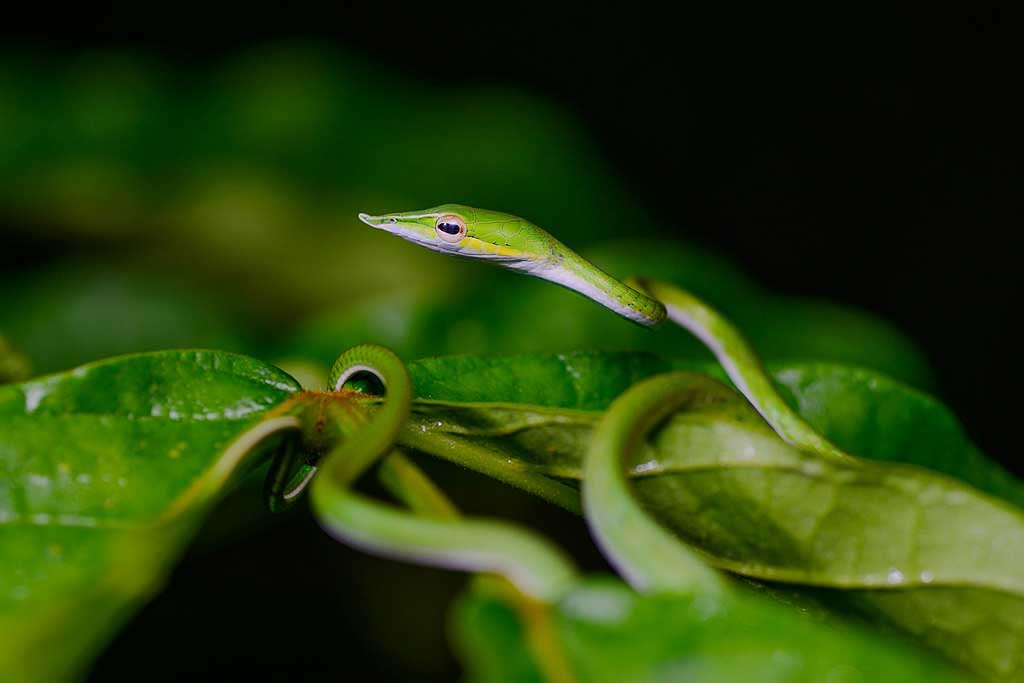
Content |
|---|
Description
Dorsal body:
Fine body, long and thin. Smooth scales, long and obliquely arranged. Parrot green or bluish green dorsal color; brown in the variety isabellinus. Regular black intercalary patterns present obliquely from the neck to much of the body.
Ventral body
Completely yellow-green belly without any pattern. Sometimes a white or yellow line separates the dorsal and ventral surfaces. Zigzag paired subcaudal scales.
Head
Long head, clearly wider than the neck, with an extremely pointed muzzle. The color of the upper lip is white or yellow. Oval-shaped eyes have horizontal pupils.
Tail
The tail, very long, thin and thin, ends in tip.
Habitat and behavior
These diurnal snakes inhabit the trees and bushes of farmland and forests.. They feed on frogs, lizards and rodents.
It tends to move very slowly and relies on its leaf-green camouflage.. Due to its thin body and green color, can easily disappear into green bushes. When disturbed, the Sri Lankan green vine snake stretches your body, shows his black and white markings and threatens the disturber with his mouth open. In South India, the legend is widespread that it blinds human victims with its pointed head.. The Sri Lankan green vine snake It, in effect, slightly poisonous and a bite causes swelling. But, symptoms usually subside within three days.
Terrarium
This tree species needs a terrarium based on height. a terrarium of 80 x 80 x 100 cm is suitable for a couple. The ground must be covered with pine chips or a mixture of river sand and peat.
You have to place many branches and plants (preferably artificial) around the terrarium so that the snake feels safe. It also, being an arboreal animal, they are essential. Keep in mind that animals are usually placed in the foliage. Although this species quenches its thirst with water spray (to be sprayed on the foliage and on the animal), a small pile of always clean water will be permanently placed in the terrarium.
Humidity
The humidity of the terrarium should be maintained between 75 and the 85%; this will be achieved with the small pile and by spraying the foliage with lukewarm water several times a week. These sprays are almost essential to maintain a sufficient hygrometry, but above all they will allow the animal to quench its thirst.
Temperature
The ideal temperature is 25-26°C during the day, with a hot spot at 27-28°C. Eliminate hot spot at night. This species tolerates quite low temperatures without problems. (15°C).
The lighting
This species is active during the day and needs high light intensity.. A tube that provides UVB light should be placed. The duration of illumination should be about 12 hours a day.
Food
The biggest problem of this species is food. In fact, this species only consumes lizards, arboreal amphibians and, more rarely, rodents in nature. In captivity, imported animals are more difficult and generally only accept lizards. From time to time they accept small mice, but they cannot be their only food. Captive-born specimens are sometimes less fussy, but it is advisable to breed a kind of small lizards “easy” to counteract the rejection of rodents. A vitamin supplement is administered once a week through the dam (subcutaneous injection to the dam).
Reproduction
Breeding remains rare for this species, but it is not a problem if the climatic conditions are respected. You can take a rest period (not required) cutting hot spot during 2 months (January-February). This species is ovoviviparous, the female gives birth 3 and 9 pups (maybe more…) that measure some 29 cm.. The gestation period is about 4 months and a half to 5 months. The young look for food quite quickly, but they usually need to have small lizards. Sometimes they accept pink mouse pups.
Note
It is a very beautiful species., still rare. Maintenance is usually not a problem, what does not happen with food.
This species is not at all recommended for beginners.
Buy one Sri Lankan green vine snake
The price of a Sri Lankan green vine snake in the exotic animal market ranges from 30 and 50 EUR.
Video Sri Lankan green vine snake
Alternative names:
1. Long-nosed whip snake (English).
2. Serpent liane (French).
3. Baumschnüffler (German).
4. Cobra-chicote de nariz comprido do Sri Lanka, Cobra-verde-cipó (Portuguese).
5. Serpiente látigo de hocico largo, Serpiente de vid común (español).
